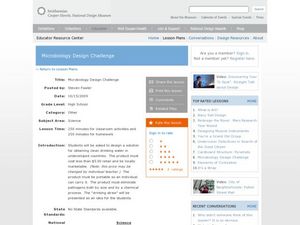Curated OER
Regents High School Examination: Living Environment 2010
This exam touches upon every topic within the typical first year biology course.. A broad variety of question styles give high schoolers every opportunity to show what they know. Why start from scratch when a comprehensive final exam is...
Smarter Balanced
Communicable Diseases
Pathogens, what they are, how they spread, and how to prevent them from spreading are the focus of this resource that can be used to prepare learners for a performance task assessment or to begin the study of communicable diseases.
Curated OER
Illness and Prevention
Fourth graders set personal health goals for preventing illness, identify different pathogens and explain how the body protects itself from pathogens, discuss ways in which prevention and transmission of disease are affected by...
Curated OER
Food Safety-Consumers Need the Facts
Learners begin by completing a survey asking them to rank their concerns about commercially prepared foods. They develop a definition of relative risk, and complete the "Pro or Con" worksheet. Students work in groups to make a study of...
Curated OER
Body Battles!
Seventh graders explain the role of white blood cells in fighting infections. In this life science instructional activity, 7th graders create flow charts showing the immune response process. They act out and play a game to simulate...
Curated OER
Defense Against Infectious Diseases
In this infectious diseases worksheet, high schoolers read about the two types of defenses the body has against pathogens: innate (nonspecific) and adaptive (specific). Students then complete a graphic organizer by filling in 11 blanks.
Curated OER
The Nature of Disease
For this disease worksheet, students read information about infectious diseases, how they are transmitted, and how they are treated. Students then complete 6 fill in the blank questions.
Curated OER
Antiseptic Nature of Plants
Students investigate the concepts of homeostasis, competition, pathogens, and antiseptics. They conduct an experiment that compares the antiseptic properties of native plants by growing bacteria on agar plates containing plant extracts,...
Curated OER
Microbes and Our Food
Students investigate foodborne illnesses and involved microbes. They identify major pathogens and then research and explain how they contaminate foods and how people are affected.
Curated OER
Diversity of Life: Pathogens
Students research bacteria and viruses that carry pathogens. In this diversity lesson, students examine how pathogens spread disease through bacteria and viruses. Students write a report on disease caused by bacteria or virus including...
Curated OER
Microbiology Design Challenge
Students discover dangers to human health by researching what's in our drinking water. In this water purification lesson, students discuss the conditions of water in undeveloped countries and why it is unsafe to drink. Students work in...
Curated OER
Preventing and Treating Disease
In this disease worksheet, students will review the organs associated with the immune system including their specific functions. This worksheet has 10 matching, 8 true or false, and 5 short answer questions.
Curated OER
Bacteria in Your Life
In this bacteria activity, students describe the process that kills harmful bacteria in milk. Then they describe what types of bacteria are helpful to farmers and which two plants have these bacteria in their roots. Students also name...
Curated OER
Skin
In this skin worksheet, 9th graders list the five main functions of the skin. Then they explain why a runner sweats and how many sweat glands there are in the body. Students also describe what occurs when the epidermis is slightly injured.
Curated OER
Ways to Prevent the Spread of Pathogens
Fifth graders discuss the ways to prevent the spread of pathogens. In groups, they use the internet to research the ways to prevent disease from spreading. They use this information to create a poster and share the information with the...
Curated OER
Describe the Perfect Pathogen
Students develop a pathogen based upon their knowledge of pathogens and after presenting it to the class, they then suggest ways that the pathogen might be combated. Next they identify possible physical or behavioral changes in a...
Curated OER
Making Vaccines
Students discuss the steps the American government has taken in order to protect every U.S. citizen from a bioterrorist attack and how a vaccine works. After discussion, students can create six vaccines in their own virtual laboratory.
Curated OER
Vaccines--How and Why?
Twelfth graders study the history, progression and current uses for vaccines in the prevention of disease. They simulate an epidemic and experiment with pathogens.
Curated OER
What Sticks Can Make You Sick
Students study adhesins and their receptors. In this science inquiry lesson students experiment to find adherence and use agglutination to identify adhesins.
Curated OER
Lymphatic and Immunity
For this biology worksheet, students identify and locate various vocabulary terms related to the lymphatic and immunity systems of the body. There are 42 biology terms located in the word search.
Curated OER
Water Quality and Temperature
Students are led through three activities to explore the effect of temperature fluctuations on the growth and survival of aquatic plants, clams, and shrimp eggs.






















